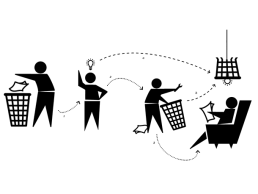
Creative Cycles
Recycled, refurbished, reimagined or repurposed, upcycling elements to create decorative lighting pieces can be a great way of introducing a unique, personalised aesthetic to an interior, as Jennifer Hamilton explains.
The one thing I aim to create in all my schemes is a sense of individuality – something to which each specific client can relate and which reflects their own personality and lifestyle.
What better way to achieve this than through the use of distinctive, one-off pieces, selected or designed with the client themselves, which gives them something they will always love and know is unique to them.
Sometimes, this takes the form of vintage pieces or antiques, sometimes artwork, and sometimes by repurposing an item that has always been in the family and giving it a new lease of life. You can even create something bespoke by putting together junk shop finds or everyday items and using them in a different way.
Lighting is a great way to do this. I believe lighting should be interesting, and varied, and we use a lot of lamps and wall lights, particularly in residential schemes to retain a relaxed feel – and to contrast with the more architectural elements of the design.
Not wanting to reuse the same thing everywhere and aiming to suit the client’s tastes and budget, while ensuring an element of individuality – means I am always on the hunt for new and creative lighting solutions.
On one recent project we created a lamp using an owl statue, which originally belonged to the client’s grandmother. We made up a new shade with a Cole & Son lining to bring it bang up-to-date.
If you do not have eccentric relatives with lofts to raid, try Alex Randall (www.alexrandall.co.uk) who has some amazing taxidermy pieces. From squirrel wall lights to pigeon chandeliers, these are emotive and exciting, and beautifully made. They also provide a fantastic talking point – and are more a piece of art than a light fitting.
Of course taxidermy isn’t for everyone and you don’t need to go to that extreme. In my house I have a lamp which my father made from an old 1920s telephone. Over the years it has had many different looks with garish 70s shades – but I think it’s far from kitsch now.
On a current project we are using a chrome chandelier, which was in the client’s master bedroom. By sending it off to be powder coated in a bright colour, we have created an entirely new feature for the refurbished double-height kitchen with vaulted ceiling.
For another recent project we trawled eBay and junk shops hunting for the perfect ‘plafonier’ lighting fitting – it is often very hard to find something vintage which a client has in their head as, of course, you are limited to the options for sale at the time. Finally, the potentially perfect fitting was tracked down to a junk shop in Chichester, and the client spent a sunny Sunday heading off to have a look, and proudly returned with it in the boot of his car. It was mucky and had several bits missing but following a rewire, clean up and repair it now looks stunning as the centerpiece of a stairwell; and the client has a great memory of seeking it out.
The current obsession with ‘vintage’ means it is getting easier to source fittings which someone has already lovingly gathered and restored – be they East German factory lights, crystal chandeliers or French barn lights, there are a great range of sources out there. Try: Retrouvius (www.retrouvius.com); Skinflint (www.skinflintdesign.co.uk); Trainspotters (www.trainspotters.co.uk); Elemental (www.elemental.uk.com); Marmorea (www.marmorealondon.com) and The French House (www.thefrenchhouse.co.uk).
The same eclectic approach to lighting can be used in commercial spaces to add a softer feel. At the SAS office in Central London, part of MSL Group, lighting played a key role in zoning areas and creating different atmospheres to break up the space. ‘Key Klamp’ scaffold structures combined with woven ‘walls’ of natural twine, divide the floors. From these screens ‘vintage’ lighting is hung – some junk shop finds and some new, but with a reclaimed or industrial feel.
There are now lots of great places selling different flex and lamp holders in different finishes – Urban Cottage (www.urbancottageindustries.com) and Dyke & Dean (www.dykeanddean.com), for example.
This makes it easy to create one-off pieces from whatever you have available – rules and regs permitting.
So, all is in place for the designer to use refurbished, vintage or up-cycled pieces in lighting schemes. It is a great way to add something unique to a project and often means you can achieve something special on a budget, and of course, it is a great way to recycle.
Jennifer Hamilton is founder and Creative Director of interior design practice The Vawdrey House.



